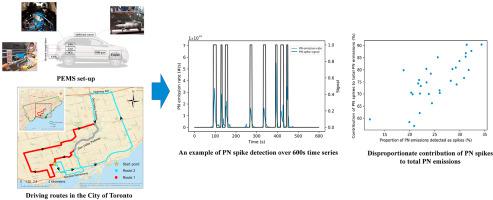Environmental Pollution ( IF 7.6 ) Pub Date : 2020-09-19 , DOI: 10.1016/j.envpol.2020.115695 Junshi Xu , Ran Tu , An Wang , Zhiqiang Zhai , Marianne Hatzopoulou

|
This study explores the generation of ultrafine particle emissions, measured in particle number (PN), based on a portable emissions measurement system (PEMS) in the City of Toronto between October and December 2019. Two driving routes were designated to include busy arterial roads and highways. All measurements were conducted between 10 am and 4 pm. Altogether, emissions from 31 drives were collected, leading to approximately 200,000 seconds of data. A spike detection algorithm was employed to isolate PN spikes in time series data. A sensitivity analysis was conducted to identify the most optimum method for spike detection. The results indicate that the average emission rate during a PN spike is approximately 8 times the emission rate along the rest of the drive. In each test trip, about 25% of the duration was attributed to spike events, contributing 75% of total PN emissions. A Pearson correlation of 0.45 was estimated between the number of PN spikes and the number of sharp accelerations (above 8.5 km/h/s). The Pearson correlation between the occurrence of high engine torque (above 65.0 Nm) and the number of PN spikes was estimated at 0.80. The number of PN spikes was highest on arterial roads where the vehicle speed was relatively low, but with high variability, and including a high number of sharp accelerations. This pattern of UFP emissions leads to a spatial distribution of high UFP concentrations along arterial roads in the inner city core.
中文翻译:

在道路排放测试中,汽油直喷车辆产生的超细颗粒物排放峰值
这项研究基于2019年10月至2019年12月在多伦多市的便携式排放物测量系统(PEMS),探索了以微粒数(PN)衡量的超细颗粒物排放的产生。指定了两条行驶路线,包括繁忙的干道和高速公路。所有测量均在上午10点至下午4点之间进行。总共收集了31个驱动器的排放量,从而获得了大约200,000秒的数据。采用尖峰检测算法来隔离时间序列数据中的PN尖峰。进行了灵敏度分析,以确定最理想的峰值检测方法。结果表明,PN峰值期间的平均发射率约为驱动器其余部分发射率的8倍。在每次测试行程中,约25%的持续时间归因于尖峰事件,贡献了PN总排放量的75%。PN尖峰次数与急剧加速次数(高于8.5 km / h / s)之间的皮尔森相关系数估计为0.45。高发动机扭矩(高于65.0 Nm)的发生与PN尖峰数量之间的皮尔森相关性估计为0.80。PN尖峰的数量在车辆速度相对较低但变化性较大且包括大量急加速的动脉道路上最高。UFP排放的这种模式导致市中心内沿主干道的UFP浓度较高的空间分布。高发动机扭矩(高于65.0 Nm)的发生与PN尖峰数量之间的皮尔逊相关性估计为0.80。PN尖峰的数量在车辆速度相对较低但变化性较大且包括大量急加速的动脉道路上最高。UFP排放的这种模式导致市中心内沿主干道的UFP浓度较高的空间分布。高发动机扭矩(高于65.0 Nm)的发生与PN尖峰数量之间的皮尔森相关性估计为0.80。PN尖峰的数量在车速相对较低但变化性较大且包括大量急加速的动脉道路上最高。UFP排放的这种模式导致市中心内沿主干道的UFP浓度较高的空间分布。









































 京公网安备 11010802027423号
京公网安备 11010802027423号